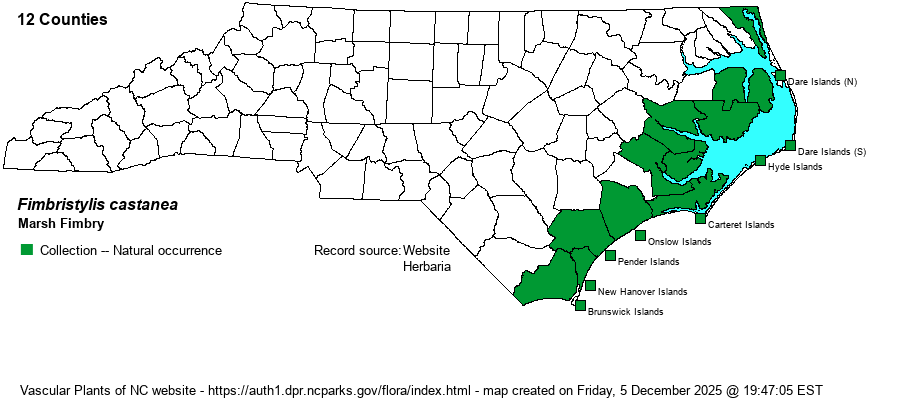| Author | (Michaux) Vahl | |
| Distribution | Outer Coastal Plain and Outer Banks/barrier islands.
Essentially maritime -- Coastal Plain, NY to southern FL and southern TX; Mex.; West Indies. | |
| Abundance | Frequent to common, and very widespread in the coastal/tidal region. The website editors suggest a State Rank of S4S5, a reflection of how numerous and widespread it is in such a rather limited area of the state. | |
| Habitat | Brackish and fresh-tidal marshes, roadsides through such marshes. |
| Phenology | Flowering and fruiting July-September. | |
| Identification | This is our most robust fimbry, with the stems potentially up to 5 feet tall but usually 2-3.5 feet. The plant bases are shiny chestnut brown and usually set deep in soil. It is very similar to F. caroliniana, which also is limited to our coastal marshes, but the leaves of that species are relatively thin and flat or V-shaped in life (vs. thick and semicircular in cross-section in F. castanea) and seeds of that species are less than 1.5 mm long (vs. 1.5-2 mm long). | |
| Taxonomic Comments | In some older texts, both F. caroliniana and F. castanea were lumped under F. spadicea (L.) Vahl.
Plants of the the genus Fimbristylis are very small to tall (3+ feet), with most leaves in a basal tuft, and an open, branched, terminal inflorescence. The spikelets are various shades of rufous, chestnut, or brown (due to the color of the scales) and resemble tiny pinecones. Important key characters include size, shape, and ornamentation of the achenes (seeds); see also other characters used by Weakley (2018). Godfrey & Wooten (1979) have excellent drawings and descriptions. | |
| Other Common Name(s) | Salt Marsh Fimbry | |
| State Rank | [S4S5] | |
| Global Rank | G5 | |
| State Status | | |
| US Status | | |
| USACE-agcp | OBL link |
| USACE-emp | OBL link |

